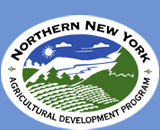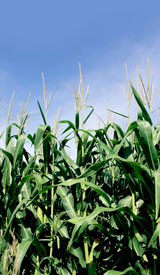January 18, 2008
Contact: Dr. Gary J. Bennett, Quality Milk
Production Services, 877-645-5523, 315-379-3930
Jpgs:
KlebsiellaLabWorkbw.jpg - At the QMPS laboratory i Canton, Dr.
Marcos Munoz from Chile examines one of many test samples collected for
the Klebsiella mastitis prevention and controls research project funded
by the Northern New York Agricultural Development Program. Photo:
Cornell University
KlebsiellaSamplingbw.jpg - Dr. Ruth N. Zadoks collects a test
sample from a dairy barn alleyway. The sample was evaluated for
Klebsiella bacteria as part of the Northern New York Agricultural
Development Program project. Photo: Cornell University
New Klebsiella Mastitis Fact Sheet Now Online at www.nnyagdev.org:
Knowledge Offers New Tool for Preventing Infection
Klebsiella bacteria cause mastitis in dairy cows. reduce milk
production, do not respond to treatment of the udder with antibiotics
and come in so many different strains that North Country farmers are
frustrated in their battle to reduce the infection. If not caught early,
Klebsiella causes cows to be permanently removed from milk production,
and the infection is often fatal to the animals. Northern New York
Agricultural Development Program-funded Klebsiella research involving
North Country dairy herds is providing new knowledge and tools for
preventing the infection. The Klebsiella Mastitis Prevention and Control
fact sheet is now online in the Dairy information section of the
regional program�s website at
www.nnyagdev.org.
New Fact Sheet Equips Farmers to Battle Infection
Doug Shelmidine of Sheland Farms in Belleville, NY, is among the
Northern New York Agricultural Development Program farmer-advisors and
was a leading proponent for the Klebsiella project that collected and
analyzed milk and manure samples from cows and from their farm
environments.
Shelmidine says, �Klebsiella has become an issue for more and more
Northern New York farms. This project gives us a look at outcomes from
several herds so each dairy can weigh the factors that influence the
rate of infection and make changes for our own operations. There may not
be a cure for Klebsiella and there are no shortcuts to cleanliness and
proper milking procedures, but the more we can learn about reducing
exposure and increasing prevention measures, the better.�
Identifying Critical Control Points
To identify critical control points to combat Klebsiella, the
farmer-driven Northern New York Agricultural Development Program (NNYADP)
enlisted the aid of regional dairy farmers and Cornell University
researchers and veterinarians Dr. Ruth Zadoks and Dr. Gary J. Bennett
with Quality Milk Production Services (QMPS). Milk, manure, feed, water
and bedding samples taken from NNY dairy herds were analyzed for
Klebsiella by the QMPS laboratories in Canton and Ithaca, NY. Several
DNA fingerprinting methods were used to identify and type hundreds of
different strains.
Zadoks says, �If you have cows, you have Klebsiella. We have found
various strains of the Klebsiella family of bacteria on farms in manure,
bedding, water, feed, and milking equipment.�
Bennett says approximately 80 percent of the cows tested in more than 10
herds over the summer of 2005 were positive for some strain of
Klebsiella in their manure. The average for Northern New York herds in
the summer of 2007 was around 60 percent. Each cow sheds multiple
strains of Klebsiella.
�On rare occasions we have seen multiple cows in the same herd with the
same strain of Klebsiella in their udders. To ensure that cows do not
infect each other, it is important to separate animals with mastitis
from the rest of the herd. Cows excrete Klebsiella in their feces and
via the manure it spreads everywhere. We think that transmission can
take place via the milking machine and via milk that leaks into the cow
stalls,� Zadoks says.
Research Shows Keeping Alleys Clean is Key
�Klebsiella does not just come from bedding. This research showed us how
big a role the cleanliness of the alleyways and of the cows plays in
this infection and provides us with new tools to prevent Klebsiella
mastitis,� Zadoks says. �Alleyway hygiene is an important and often
overlooked component of Klebsiella control.�
When cows walk through manure in alleyways, they contaminate their
udders, teats and legs. Then they lie down with their teats on top of
their manure-soiled legs creating further exposure to the Klebsiella.
Two out of three cows tested in Northern New York had Klebsiella on her
legs and the skin of her teats.
�We are directing farmer attention to alleyways, including the exit from
the milking parlor, and holding pens, where Klebsiella is extremely
common,� Zadoks says.
Developing vaccines to fight the many strains of Klebsiella is a
long-term prospect. Vaccination strategies that work against the less
aggressive E. coli bacteria do not work with Klebsiella.
What can farmers do while waiting for a vaccine to fight Klebsiella,
which can be signaled by a rise in somatic cell count?
Diligence to Proper Milking Practices Reduces Risk
Dairyman Andrew Bilow milks 1,000 cows at the farm he co-owns with his
father and cousin in Malone, NY. The farm has been named a Dairy of
Distinction noted for its cleanliness for the past 10 years.
�Our somatic cell count was climbing and we could not find a reason why.
After participating in this Klebsiella project, we changed our pre-dip
and post-dip treatments and our counts fell to consistently-acceptable
levels within six months,� Bilow says.
At the W.H. Miner Agricultural Research Institute in Chazy, NY,
Herdsperson Anna Pape helps oversee a milking herd of 280 cows.
�This project confirmed that we needed to remain diligent to good
milking practices. We are paying particular attention to cleaning teat
ends to reduce the opportunity for exposure when they open to let the
milk out,� Pape says.
�And now that we understand the true lack of sensitivity to antibiotics
by Klebsiella, we are better at treating infected cows with hydration
and pain management, reducing their exposure to secondary infections,
and feeding alfalfa meal and electrolytes to maintain their appetite,�
Pape adds.
Bedding and Stall Changes Can Help
Zadoks says that testing of various types of dairy bedding shows that
switching from sawdust and other bedding with high organic matter to
sand bedding can decrease Klebsiella exposure. She cautions, however,
that once sand bedding that tests Klebsiella-free prior to use is put
into the barn and becomes contaminated with manure, it can become a
source of the Klebsiella infection.
Bilow and Pape both say their farms will make adjustments in the barn to
reduce exposure. Bilow Dairy will convert to using sand bedding in 2008.
The Miner Institute dairy barn is not set up to use sand bedding and has
larger-than-industry-standard size stalls to promote cow comfort. Pape
says, �We are looking at adjusting the brisket boards to position the
cows farther back in the stall so more manure will fall into the alley
and not in the stall.� At any time of year, �stand, alley and barn
hygiene is critical for controlling exposure to Klebsiella. Using
bedding with the least amount of organic matter reduces exposure.
Milking cows you know to be infected last and disinfecting equipment
after milking cows with mastitis are also good practices,� Zadoks says.
�Each farm must develop a plan for its unique conditions.�
Some good news for farmers in the colder climate of Northern New York is
that the rate of Klebsiella-based mastitis tends to be lower in winter
months.
The Klebsiella Mastitis Prevention and
Control fact sheet can be downloaded from the Northern New York
Agricultural Development Program website at
www.nnyagdev.org.
The Klebsiella Mastitis Prevention and Control fact sheet on the
sources, transmission and control methods for Klebsiella-based mastitis
will be sent to producers whenever the QMPS labs identify Klebsiella in
one of that producer�s farm samples. Veterinarians and Cornell
Cooperative Extension educators will be distributing the Klebsiella fact
sheet to dairy producers in Clinton, Essex, Franklin, Jefferson, Lewis
and St. Lawrence counties.
A committee of dairy, fruit, livestock, maple and vegetable producers
guides the Northern New York Agricultural Development Program that funds
research and educational outreach with practical results for NNY
farmers. Dairymen Jon Greenwood of Canton and Joe Giroux of Plattsburgh
co-chair the program. #



